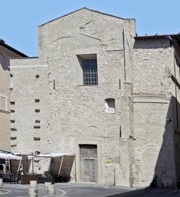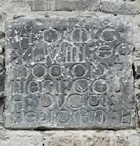
Paola Guerrini and Francesca Latini (referenced below, at p. 138 - see also p. 302, entry 79) made the interesting suggestion that the location and, in particular, the dedication of this church might point to an ancient foundation:
-
“The diffusion in Italy of the cult of Sant’ Apollinare occurred ... in the 6th century, with the ‘Byzantine’ domination, to the point of becoming emblematic of Byzantine presence and hegemony in the west. In Umbria, it was widely diffused, thanks in part to the channels of communication between Rome and Ravenna represented by Via Amerina and Via Flaminia. This supports the hypothesis [developed in this book] of the presence here of a strategically placed fortress that housed this cult site dedicated to St Apollinaris of Ravenna, which had been founded following the Byzantine reconquest [in 554] and which resulted in the urban settlement of the area around the fortress itself” (my translation).
Whether or not this suggestion is correct, surviving documents only date back to the 12th century:
-
✴in 1129, it was used to define one boundary of a property in civitas Sancti Feliciani; and
-
✴in 1138, Pope Innocent II confirmed it as a possession of the Bishop Benedetto of Foligno.

The Confraternita della Morte was established here in 1566, and the church is alternatively known as the Chiesa della Morte.
The interior was remodelled in the form of a Greek cross in 1728, to a design by Sebastiano Cipriani.
The church is now closed, although it has recently been restored.
Annunciation (1792)
Bishop Filippo Trenta commissioned this oval panel from Gaetano Gandolfi in 1789 for the high altar of the Chiesa della SS Trinità in Annunziata. When that church closed in 1860, the panel was moved to Sant’ Apollinare. [Is it still here?]
Panels in Sant’ Apollinare (early 18th century)
Two panels were documented in Sant’ Apollinare in 1728, with an attribution to Giuseppe Nicola Nasini:
-
✴the Deposition; and
-
✴the Resurrection of Christ.
They [remain in the church?] and are illustrated in black and white in the website of the Fondazione Federico Zeri.
Read more:
P. Guerrini and F. Latini, “Foligno: Dal Municipium Romano alla Civitas Medievale: Archeologia e Storia di una Città Umbra”, (2012) Spoleto
Return to the page on Monuments of Foligno.
Return to Walk II.



